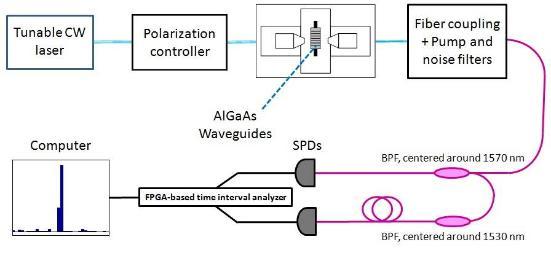Semiconductor Optoelectronics for Quantum Technologies
A key requirement for Photonic Quantum Technologies is a correlated photon source. We have applied our expertise and research in nonlinear optical conversion in semiconductor waveguides to obtain integrable solutions for correlated photon sources at telecommunication wavelengths.
The III-V implementation uses the quasi-phase-matched approach to exploit second-order nonlinearities in III-V superlattice waveguide using selective area quantum well intermixing induced by ion implantation (see Optical Frequency Conversion). Spontaneous parametric down-coversion, also known as parametric fluorescence, provides an optical source centered around 1546nm with a continuous-wave pump wavelength of 773nm. Coincidence measurements were performed with single photon detectors after wavelength demultiplexing using 1562-1578nm and 1522-1538nm bandpass filters. A CAR of over 100 was measured at 1.9x106 generated photon pairs/second.


As we have also demonstrated monolithic integration compatibility with p-i-n diode laser pump sources in similar GaAs/AlGaAs superlattice waveguides, along with dichroic couplers, we have the basis for developing a fully-integrated correlated photon source on a III-V chip.
People
- Prof. David C. Hutchings
- Dr. Barry M. Holmes
- Dr. Marc Sorel
This research has been undertaken in collaboration with Prof. Li Qian, Prof. Stewart Aitchison and Peyman Sarrafi, University of Toronto. The contributions of the EPSRC National facilities are acknowledged: III-V Technologies, University of Sheffield and University of Surrey Ion Beam Centre.
Publications
- Sarrafi, P., Zhu, E. Y., Holmes, B. M., Hutchings, D. C. , Aitchison, S. and Qian, L. (2014) High-visibility two-photon interference of frequency–time entangled photons generated in a quasi-phase-matched AlGaAs waveguide. Optics Letters, 39(17), p. 5188. (doi:10.1364/OL.39.005188)
- Sarrafi, P., Zhu, E.Y., Dolgaleva, K., Holmes, B.M., Hutchings, D. , Aitchison, J.S. and Qian, L. (2013) Continuous-wave quasi-phase-matched waveguide correlated photon pair source on a III–V chip. Applied Physics Letters, 103(25), p. 251115. (doi:10.1063/1.4851095)
- Azzini, S., Grassani, D., Strain, M.J., Sorel, M., Helt, L.G., Sipe, J.E., Liscidini, M., Galli, M., and Bajoni, D (2012) Ultra-low power generation of twin photons in a compact silicon ring resonator. Optics Express, 20 (21). pp. 23100-23107. ISSN 1094-4087 (doi:10.1364/OE.20.023100)

